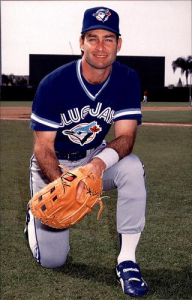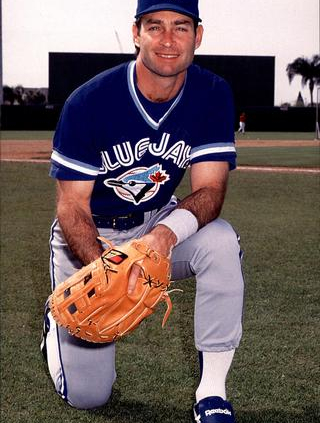April 19, 1993: Paul Molitor packs two hits, visit to dying girl into busy 48 hours
 Despite his busy schedule as one of baseball’s top hitters with the Milwaukee Brewers, Paul Molitor took time to partake in some dress-up in the middle of the 1991 season. Before a July 31 night game, Molitor made an appearance at the Women for the Midwest Athletes Against Childhood Cancer Children’s Luncheon and Fashion Show in Milwaukee and walked down the runway with 9-year-old cancer survivor Lauren Ball, a huge fan of his.
Despite his busy schedule as one of baseball’s top hitters with the Milwaukee Brewers, Paul Molitor took time to partake in some dress-up in the middle of the 1991 season. Before a July 31 night game, Molitor made an appearance at the Women for the Midwest Athletes Against Childhood Cancer Children’s Luncheon and Fashion Show in Milwaukee and walked down the runway with 9-year-old cancer survivor Lauren Ball, a huge fan of his.
That afternoon marked the first steps in a nearly two-year-long friendship that featured plenty of ice cream, phone calls, and greeting cards but ended with one final visit on April 19, 1993.
“Something told me I have to see her in person,” Molitor told Lauren’s mother, Heidi, after learning Lauren had again been hospitalized.1
Molitor, who left the Brewers for the Toronto Blue Jays going into the 1993 season, called in a favor only a dozen games into his tenure with his new team. After helping the Blue Jays win 7-1 in an afternoon game in Cleveland on April 19, Molitor traveled to Milwaukee to visit Lauren before rejoining his teammates in Kansas City for a night game on April 20.
It would be the last time he saw Lauren alive. Lauren, who had owned a cherished Molitor puppet since age 4, died from complications from an inoperable tumor behind her eye on May 23, the day before Molitor was scheduled to play against the Brewers for the first time. It was the second tumor doctors had discovered during her life.
“I visit hospitals and things, but this girl has become a special friend to me,” Molitor said. “You see a lot of very sad things, and sometimes one hits you more than others and you just kind of hit it off with the person. She’s been a real encouragement to me, just because of her optimism and the way she’s handled all this adversity at such a young age. It’s been amazing.”2
“I knew she was close to passing away, and I was worried,” Molitor later added. “A lot of people visit hospitals and things, and if you do that enough you’ll find some kids you really get attached to, and that’s what happened. It was a very sad end, but I think it was a real positive experience for both of us. It was very special.”3
Throughout his 15 seasons with the Brewers, Molitor became known as a devoted philanthropist. He regularly volunteered with organizations like the Boys & Girls Clubs, Make-a-Wish Foundation, Big Brothers & Big Sisters, Special Olympics, and Milwaukee AIDS Project, and he often bought tickets for disadvantaged youth and seniors in Milwaukee.4
Molitor, 36, signed a three-year, $13 million contract with the Blue Jays, the defending World Series champions, and parlayed that into one of the best seasons of his career. He led the American League with 211 hits, hit .332, and was runner-up in the AL MVP voting, the highest finish in his 21-year career. And his two hits against Cleveland before visiting Lauren were a small step toward reaching those totals.
Toronto opened the scoring in front of 11,750 fans at Cleveland Stadium when Joe Carter led off the second inning with a double off Cleveland starter Mike Bielecki and scored on John Olerud’s single. Cleveland evened the score in the third when Kenny Lofton walked, stole second and third, and scored on Albert Belle’s double, which extended Belle’s hitting streak to 12 games.5 Molitor singled with one out in the fourth and scored on Darrin Jackson’s single, giving Toronto starter Juan Guzmán the last bit of support he needed to pick up his first victory of the season.
Guzmán had struggled in his first two starts, allowing 12 earned runs on 17 hits in 8⅔ innings (a 12.46 ERA), but he located his fastball and his slider wiped out several Cleveland hitters to get his season back on track. Akron Beacon-Journal reporter Sheldon Ocker wrote, “You can almost see the vapor trail from his fastball, and his slider can make grown major-leaguers cry” after Guzmán allowed only four hits and struck out seven on 124 pitches in seven innings.6 The lone drawback to his start was that he also walked six (one intentionally).
“I really got ready for this game because I haven’t been pitching well lately,” said Guzmán, the runner-up in 1991 AL Rookie of the Year voting and a 1992 All-Star selection. “Those first two starts I was fighting two things: the location of my pitches and the flu. It was much better today.”7
Toronto extended its lead in the fifth when former Indians prospect Turner Ward broke a 1-for-19 skid by socking a three-run home run to deep right off Bielecki. He offered up another long ball in the seventh, when Roberto Alomar tagged him for a solo shot to right, the first homer of Alomar’s season and second of his three hits in the game. Manager Mike Hargrove pulled Bielecki when Molitor threatened to turn the inning into another rally by lining a 2-and-2 pitch to left field for a two-out single. Both home runs Toronto hit came on 3-and-2 counts, and Bielecki pinpointed the culprit as pitch selection rather than his return from shoulder surgery that cost him the final two months of the 1992 season with the Atlanta Braves.
“It all comes down to making good pitches, and I didn’t make them when I had to,” Bielecki said. “I’ve been nibbling at the plate when I don’t have to, and if I could do it all over again, I’d be more aggressive. It was a mistake, but I’ve been through periods like this before and I’ll be OK.”8
“Nothing’s wrong with my arm. I feel my stuff is there,” Bielecki added after his ERA ballooned to 8.27 in three starts. “I’m just not making good pitches when I have to.”9
Olerud led off the eighth with a solo home run to close the scoring. It marked the second time the Blue Jays had hit three homers against the Indians in 1993.10 Toronto’s victory split the series at two games apiece, moving the Blue Jays to 7-5 in the young season. Cleveland dropped to 5-8. Still, Blue Jays manager Cito Gaston seemed pleased to be done playing the Indians for a while.
“When do we play them again? August? Good,” Gaston said after his club allowed 45 runs to Cleveland, despite winning four of seven early-season matchups. “I’m glad to get out of here. You’ve got to pitch well and play well to beat them. They may not have as much pitching as they would like, but they’ll put some numbers up on the board.”11
Guzmán proved a key cog on the way to Toronto’s World Series title, as he did not lose until June 10. He also stayed out of the loss column over the final two months of the season, finishing the campaign at 14-3 and lowering his ERA to a respectable 3.99. He later won two games in the AL Championship Series and started twice in the World Series, which the Blue Jays won in six games over the Phillies.
Molitor maintained an equally important role. In the ALCS, he hit .391 and scored seven times as the Blue Jays knocked off the Chicago White Sox in six games. Against the Phillies, Molitor won World Series MVP honors after hitting .458 with 10 runs, 7 extra-base hits, and 7 RBIs. Fans chanted “MVP-MVP-MVP” as he rounded the bases after homering in the decisive Game Six victory, and after the game, he was announced as the first designated hitter to win MVP honors.
But when he thinks back to that time of his life, he undoubtedly also thinks about a little girl and the life she should have lived—because that’s just the type of man Paul Molitor is.
“Paul has always been there,” said Scott Ball, Lauren’s father. “It’s something where he’s very sincere and genuine in all of his actions. He really lifted Lauren’s spirits by being a friend in some grave times. When she was really down, Paul would come, and she just brightened up. … We were given a gift back in ’91. We got Lauren back for a year and a half. Lauren fought long and hard. Someone came in, a childhood idol, and said, ‘I’ll be there for you, honey.’ He’s done that.”12
So, when Milwaukee’s B.J. Surhoff had this to say following Molitor’s departure to Toronto in December 1992, he spoke for more people than his teammates: “It could take me all day to tell you everything. I don’t know if I could sum it up in a few words what Paul means. I could fill a whole page of your newspaper with how I feel toward him and how much we’ll miss him.”13
Acknowledgments
This article was fact-checked by Evan Katz and copy-edited by Len Levin.
Photo credit: Trading Card DB.
Sources
In addition to the sources cited in the Notes, the author consulted the Baseball-Reference.com, Stathead.com, and Retrosheet.org websites for pertinent materials and the box scores. He also used information obtained from news coverage by the Cleveland Plain Dealer, the Akron Beacon-Journal, the Wisconsin State Journal, and the Toronto Star.
https://www.baseball-reference.com/boxes/CLE/CLE199304190.shtml
https://www.retrosheet.org/boxesetc/1993/B04190CLE1993.htm
Notes
1 Tom Flaherty (Milwaukee Journal), “Her Favorite Player Became Her Special Friend,” Atlanta Constitution, May 25, 1993: E1.
2 Flaherty.
3 Jim Byers (Toronto Sun), “Blue Jays’ Paul Molitor: Normal Guy With a Hot Bat,” Sault St. Marie (Ontario) Sault Star, June 11, 1993: A8.
4 “Charities Will Miss Molitor,” Wisconsin State Journal (Madison), December 9, 1992: 5B.
5 Belle had two hits the next night, but the streak ended at 13 games. In 1997 he hit in 27 straight games for the White Sox between May 3 and June 1 for the longest hitting streak of his career.
6 Sheldon Ocker, “Guzmán Accelerates to Beat Indians 7-1,” Akron Beacon-Journal, April 20, 1993: D1.
7 Dennis Manoloff, “Ward Healer: Outfielder Feeling Better After First HR,” Cleveland Plain Dealer, April 20, 1993: 3E.
8 Russell Schneider, “Jays’ Guzmán Stops Tribe, Gives Up Four Hits in 7-1 Win,” Cleveland Plain Dealer, April 20, 1993: 1E.
9 Chuck Melvin (Associated Press), “Guzmán Strong in Blue Jays’ Rout,” Galion (Ohio) Inquirer, April 20, 1993: 8.
10 The first three-homer showing occurred one week earlier on April 11, when Carter, Ed Sprague, and Devon White each homered in a 10-6 loss to Cleveland. The Blue Jays later hit three home runs against Cleveland on August 16 and August 23, accounting for a quarter of their games from 1993 with three or more homers.
11 Dave Perkins, “Guzmán’s Arm Comes Around at Right Times,” Toronto Star, April 20, 1993: B2. By the end of the season, Cleveland had scored the fifth-most runs and recorded the fourth-best batting average in the AL but finished sixth in the AL East, 19 games behind the Blue Jays.
12 Flaherty, “Her Favorite Player Became Her Special Friend.”
13 Andy Baggot, “Molitor Leaves Void,” Wisconsin State Journal, December 9, 1992: 5B.
Additional Stats
Toronto Blue Jays 7
Cleveland Indians 1
Cleveland Stadium
Cleveland, OH
Box Score + PBP:
Corrections? Additions?
If you can help us improve this game story, contact us.


